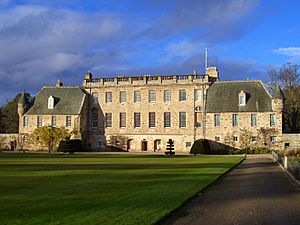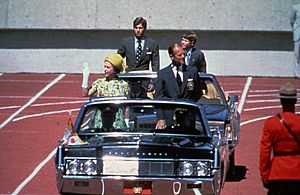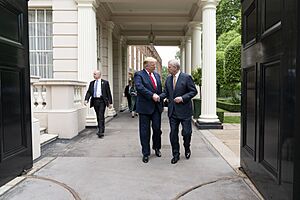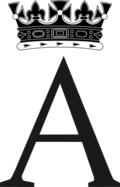Andrew Mountbatten Windsor facts for kids
Quick facts for kids Andrew Mountbatten Windsor |
|||||
|---|---|---|---|---|---|
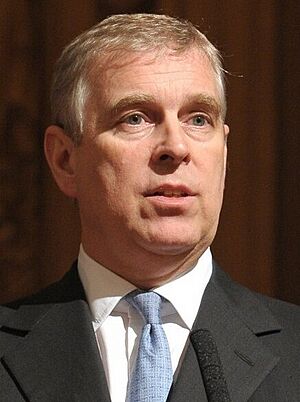
Andrew in 2013
|
|||||
| Born | Prince Andrew 19 February 1960 Buckingham Palace, London, England |
||||
| Spouse | |||||
| Issue | |||||
|
|||||
| House | Windsor | ||||
| Father | Prince Philip, Duke of Edinburgh | ||||
| Mother | Elizabeth II | ||||
| Education |
|
||||
| Military career | |||||
| Allegiance | United Kingdom | ||||
| Service/ |
Royal Navy | ||||
| Years of active service | 1979–2001 | ||||
| Rank | Vice admiral (honorary) | ||||
| Battles/wars | Falklands War | ||||
| Signature | |||||
 |
|||||
Andrew Albert Christian Edward Mountbatten Windsor (born 19 February 1960) is the third child and second son of Queen Elizabeth II and Prince Philip, Duke of Edinburgh. He is a younger brother of King Charles III. Andrew was born second in the line of succession to the British throne. As of 2025, he is eighth in line.
Andrew served in the Royal Navy from 1979 to 2001. He was a helicopter pilot and instructor, and later captained a warship. During the Falklands War, he flew many missions. These included anti-surface warfare, helping injured people, and acting as a decoy for missiles. He married Sarah Ferguson in 1986 and became the Duke of York on his wedding day. They have two daughters: Princess Beatrice and Princess Eugenie. Their marriage, separation in 1992, and divorce in 1996 received much media attention. Andrew undertook official duties for Queen Elizabeth II until 2019. In January 2022, Queen Elizabeth II changed his honorary military roles and royal charity patronages. He also stopped using the style "His Royal Highness" in public. In October 2025, King Charles III began a formal process to change his style, titles, and honours. Andrew also moved from his home, Royal Lodge, to a property on the Sandringham Estate in Norfolk.
Early Life and Education
In 1959, Queen Elizabeth II found out she was expecting a baby during a tour of Canada. The news was shared with the public on August 7, when Buckingham Palace announced she would not take on more public events.
Andrew was born a prince at Buckingham Palace on 19 February 1960. He was the third child and second son of Queen Elizabeth II and Prince Philip, Duke of Edinburgh. He was christened Andrew Albert Christian Edward on 8 April 1960.
Andrew was the first child born to a reigning British monarch since 1857. Like his siblings, Charles, Anne, and Edward, Andrew had a governess for his early education at Buckingham Palace. He later attended Heatherdown School near Ascot. In September 1973, he went to Gordonstoun in Moray, Scotland, a school his father and older brother also attended. He spent six months in 1977 on an exchange program at Lakefield College School in Canada. He finished school in July 1979.
The Royal Household announced in November 1978 that Andrew would join the Royal Navy. He passed various tests and interviews to become a trainee helicopter pilot. On 11 May 1979, he signed up for 12 years of service. He became a midshipman on 1 September 1979 and entered Britannia Royal Naval College, Dartmouth. He also completed the Royal Marines All Arms Commando Course and earned his Green Beret. On 1 September 1981, he became a sub-lieutenant.
After training at Dartmouth, Andrew learned to fly helicopters with the Royal Air Force and the navy. He flew the Gazelle and later the Sea King helicopter. He then joined 820 Naval Air Squadron and served aboard HMS Invincible, an aircraft carrier.
Serving in the Falklands War
On 2 April 1982, Argentina invaded the Falkland Islands, which led to the Falklands War. HMS Invincible was an important aircraft carrier in the Royal Navy task force sent to take back the islands.
The British government was concerned about one of the Queen's sons being in danger. However, the Queen insisted that Andrew stay with his ship. Andrew remained on board Invincible as a Sea King helicopter co-pilot. He flew missions such as anti-submarine and anti-surface warfare, missile decoy, and rescue operations. He saw the Argentine attack on SS Atlantic Conveyor.
After the war, Invincible returned to Portsmouth. Queen Elizabeth and Prince Philip welcomed the ship home with other families. Andrew continued to serve with Invincible until 1983. Commander Nigel Ward described Andrew as "an excellent pilot and a very promising officer."
In 1983, Andrew trained to fly the Lynx helicopter. On 1 February 1984, he was promoted to lieutenant. Queen Elizabeth appointed him as her personal aide-de-camp. Andrew served aboard HMS Brazen as a flight pilot until 1986. He also completed a helicopter warfare instructor's course. From 1987 to 1988, he was a helicopter warfare officer. He also served on HMS Edinburgh until 1989.
Andrew was a flight commander and pilot on HMS Campbeltown from 1989 to 1991. He passed the squadron command examination in 1991 and the ship command examination in 1992. He was promoted to lieutenant-commander on 1 February 1992. From 1993 to 1994, Andrew commanded the minehunter HMS Cottesmore.
From 1995 to 1996, Andrew was a senior pilot for 815 Naval Air Squadron. He was promoted to commander on 27 April 1999. He finished his active naval career at the Ministry of Defence in 2001. In July of that year, Andrew retired from the active list of the Navy. He was later made an honorary captain in 2004. On his 50th birthday in 2010, he was promoted to rear admiral. Five years later, he became a vice admiral.
He stopped using his honorary military titles in January 2022. This decision followed requests from many military veterans. In November 2025, Defence Secretary John Healey stated that the government acted to remove Andrew's honorary status as vice admiral. This was his final remaining military title.
Personal Life
Relationships and Family
Before Marriage
Andrew met American photographer and actress Koo Stark in February 1981. They took a holiday together in 1982. They separated in 1983 due to pressure from the media. In 1997, Andrew became godfather to Stark's daughter.
Marriage and Children
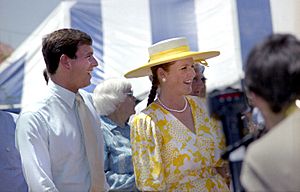
Andrew married Sarah Ferguson at Westminster Abbey on 23 July 1986. On the same day, Queen Elizabeth made him Duke of York, Earl of Inverness, and Baron Killyleagh. These titles were previously held by his maternal grandfather, George VI, and his great-grandfather George V. Andrew had known Ferguson since childhood. They reconnected at Royal Ascot in 1985.
The couple seemed happy at first and had two daughters: Beatrice and Eugenie. Sarah's friendly personality was seen as a refreshing change within the royal family. Andrew's frequent military travel and constant media attention on Sarah led to difficulties in their marriage. On 19 March 1992, they announced their plans to separate. The marriage ended in divorce on 30 May 1996. Andrew spoke kindly of his former wife in 2008. He said they worked well together to raise their children.
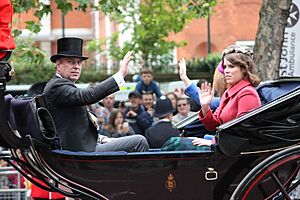
Residences
Andrew and Sarah shared custody of their daughters. The family lived at Sunninghill Park until Andrew moved to the Royal Lodge in 2004. In 2007, Sarah moved into Dolphin House, close to Royal Lodge. After a fire at Dolphin House in 2008, Sarah moved back into Royal Lodge, sharing the home with Andrew. As of 2025, they were still living there together. Andrew's lease for Royal Lodge was for 75 years. He paid a one-time fee and committed to spending money on renovations. In March 2023, it was reported that Andrew was offered Frogmore Cottage. This offer came after his nephew Prince Harry was asked to leave the residence. In October 2025, it was reported that Andrew paid a small rent for Royal Lodge. This was in exchange for upfront payments of £8.5 million. The agreement stated he and his family could live there until 2078. Later that month, Buckingham Palace announced that Andrew moved to a different home on the Sandringham Estate.
Andrew enjoys skiing. In 2014, he bought a skiing chalet in Verbier, Switzerland, for £13 million with his ex-wife. In May 2020, they faced a legal dispute over the mortgage. In September 2021, Andrew and Ferguson reached an agreement to sell the house. The money from the sale was reportedly used to help with Andrew's legal expenses. In June 2022, a Swiss newspaper reported that the chalet was frozen due to a £1.6 million debt Andrew owed.
Health and Interests
On 2 June 2022, Andrew tested positive for COVID-19. He did not attend the Platinum Jubilee National Service of Thanksgiving on 3 June.
Andrew is a keen golfer. He was captain of the Royal and Ancient Golf Club of St Andrews from 2003 to 2004. He was also a patron of several royal golf clubs.
Charitable Work
Supporting Charities
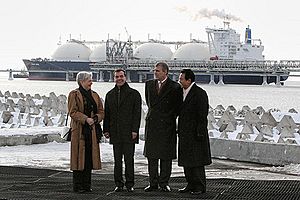
Andrew was a patron of the Middle East Association (MEA). This organization promotes trade and good relations with the Middle East, North Africa, Turkey, and Iran. After his role as Special Representative for International Trade and Investment ended, Andrew continued to support UK businesses. He was especially passionate about helping young entrepreneurs.
He was also a patron of Fight for Sight. This charity researches ways to prevent and treat blindness. He was a member of the Scout Association. He often visited Canada for his Canadian military duties. Rick Peters, a former commanding officer, said Andrew was "very well informed on Canadian military methods." He became a patron of the charity Attend in 2003. He was also a member of the International Advisory Board of the Royal United Services Institute.
On 3 September 2012, Andrew joined a team of 40 people who abseiled down The Shard. This event raised money for educational charities like the Outward Bound Trust and the Royal Marines Charitable Trust Fund. He supported science and technology organizations. He became a patron of Catalyst Inc and TeenTech. In 2014, Andrew visited Geneva, Switzerland, to promote British science at CERN's 60th anniversary.
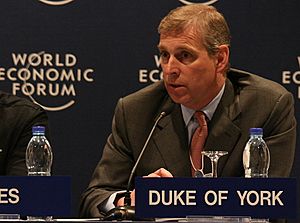
In 2013, Andrew became a patron of London Metropolitan University and the University of Huddersfield. In July 2015, he became Chancellor of the University of Huddersfield. In recognition of his work promoting entrepreneurship, he was elected to an Honorary Fellowship at Hughes Hall in the University of Cambridge in 2018. In November 2019, the Students' Union of the University of Huddersfield asked him to resign as chancellor. Andrew then stepped down from this role on 21 November 2019.
In March 2019, Andrew took over the patronage of the Outward Bound Trust from his father. He served until his resignation in November 2019. He had been chairman of the trust's board since 1999. In May 2019, he became patron of the Royal Fine Art Commission Trust.
On 13 January 2022, his royal patronages were returned to the Queen. They were then given to other members of the royal family. In January 2023, King Charles III allowed Andrew to pursue some business interests.
In July 2025, research was published on the impact of Andrew's charity patronages. The study found no major differences in charity revenues after his patronages ended. This suggested that having a royal patron did not always help charities.
Special Initiatives
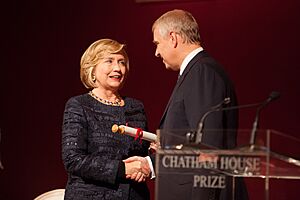
During a tour of India in 2012, Andrew became interested in the Women's Interlink Foundation (WIF). This charity helps women learn skills to earn money. He and his family started Key to Freedom. This project helps sell products made by WIF.
In 2014, Andrew founded the Pitch@Palace initiative. This program supports entrepreneurs by helping them share and grow their business ideas. Entrepreneurs invited to Pitch@Palace Bootcamp presented their ideas at St James's Palace. They connected with potential investors, mentors, and business contacts. In May 2018, he visited China to open Pitch@Palace China Bootcamp 2.0.
Andrew founded The Prince Andrew Charitable Trust. This trust aimed to support young people in areas like education and training. He also created several awards. These include the Inspiring Digital Enterprise Award (iDEA) for digital skills. There is also the Duke of York Award for Technical Education and the Duke of York Young Entrepreneur Award. Andrew was also involved with the Duke of York's Community Initiative. This group supported voluntary organizations in Yorkshire.
Trade and Public Service
Special Representative for International Trade and Investment
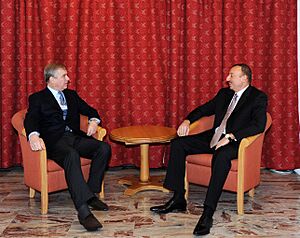
From 2001 to July 2011, Andrew worked with UK Trade & Investment. He was the United Kingdom's Special Representative for International Trade and Investment. In this role, he represented and promoted the UK at trade events worldwide. He stepped down from this role in 2011.
Andrew did not receive a salary for this role. However, his trips were paid for by expenses. In 2010, his expenses as a trade envoy were reported to be £620,000. This included £154,000 for hotels and hospitality, and £465,000 for travel.
Finances and Support
Andrew received an annual payment of £249,000 from Queen Elizabeth II. King Charles III changed this in April 2023. He also has a Royal Navy pension of £20,000.
In June 2019, Andrew arranged a private tour of Buckingham Palace. This was for businessmen from a US cryptocurrency company. This company had agreed to pay his ex-wife Sarah Ferguson for her role as a "brand ambassador." Court documents showed Andrew also received £60,500 from businesses connected to one of the businessmen.
In March 2022, it was reported that the wife of a former Turkish politician transferred £750,000 to Andrew. She believed it would help her secure a passport. He repaid the money 16 months later. The Telegraph reported that the money was described as a "wedding gift" for his elder daughter, Princess Beatrice. In October 2025, it was reported that Andrew received £60,500 from businessman Adrian Gleave in December 2019.
In October 2025, The Guardian reported that Andrew received a one-off payment from King Charles III's private funds. This helped him finance his move from Royal Lodge to a smaller property. He was also granted an annual stipend, which is several times his naval pension.
Titles, Styles, Honours, and Arms
Titles and Styles
As a son of the reigning monarch, he was styled "His Royal Highness The Prince Andrew" at birth. On 23 July 1986, he became Duke of York, Earl of Inverness, and Baron Killyleagh. He then used the style "His Royal Highness The Duke of York." He was sometimes known as Earl of Inverness in Scotland and Baron Killyleagh in Northern Ireland.
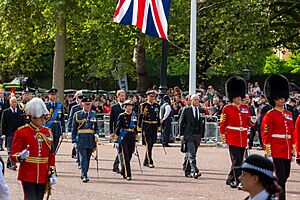
In January 2022, Andrew stopped using the style "His Royal Highness" in public. He was still allowed to use it privately.
On 17 October 2025, Andrew agreed to stop using his peerages and honours. This followed discussions with Charles III. These included his dukedom and knighthoods. His banner of arms, which hung in St George's Chapel, Windsor Castle, was removed.
He continued to use the title "prince" until 30 October. On that date, Buckingham Palace announced that Charles III had started a formal process to change his brother's style, titles, and honours. His name was then removed from the Roll of the Peerage. This meant he was no longer addressed by titles from his peerages in official documents.
As of 2025, Andrew is eighth in the line of succession to the British throne.
 1979–1981: Midshipman, Britannia Royal Naval College, HMS Seahawk
1979–1981: Midshipman, Britannia Royal Naval College, HMS Seahawk 1981–1984: Sub Lieutenant, Pilot, 820 NAS on HMS Invincible
1981–1984: Sub Lieutenant, Pilot, 820 NAS on HMS Invincible 1984–1992: Lieutenant, Pilot, 815 NAS on HMS Brazen; Helicopter Warfare Instructor, 702 NAS at RNAS Culdrose; Flight Commander, 829 NAS on HMS Campbeltown
1984–1992: Lieutenant, Pilot, 815 NAS on HMS Brazen; Helicopter Warfare Instructor, 702 NAS at RNAS Culdrose; Flight Commander, 829 NAS on HMS Campbeltown 1992–1999: Lieutenant Commander, Captain, HMS Cottesmore; Senior Pilot, 815 NAS at RNAS Portland; Directorate of Naval Operations, Ministry of Defence
1992–1999: Lieutenant Commander, Captain, HMS Cottesmore; Senior Pilot, 815 NAS at RNAS Portland; Directorate of Naval Operations, Ministry of Defence 1999–2005: Commander, Diplomacy Section of the Naval Staff. Released from the active list in 2001.
1999–2005: Commander, Diplomacy Section of the Naval Staff. Released from the active list in 2001. 2005–2010: Honorary Captain
2005–2010: Honorary Captain 2010–2015: Rear Admiral
2010–2015: Rear Admiral 2015: Vice Admiral
2015: Vice Admiral
Honours and Appointments
Commonwealth Honours
 21 February 2011: Knight Grand Cross of the Royal Victorian Order (GCVO)
21 February 2011: Knight Grand Cross of the Royal Victorian Order (GCVO)
- 2 June 2003 – 21 February 2011: Knight Commander of the Royal Victorian Order (KCVO)
- 19 December 1979 – 2 June 2003: Commander of the Royal Victorian Order (CVO)
 23 April 2006: Royal Knight Companion of the Most Noble Order of the Garter (KG)
23 April 2006: Royal Knight Companion of the Most Noble Order of the Garter (KG) 2015: Grand Companion of the Order of Logohu
2015: Grand Companion of the Order of Logohu 1977: Queen Elizabeth II Silver Jubilee Medal
1977: Queen Elizabeth II Silver Jubilee Medal 1982: South Atlantic Medal, with Rosette
1982: South Atlantic Medal, with Rosette 2002: Queen Elizabeth II Golden Jubilee Medal
2002: Queen Elizabeth II Golden Jubilee Medal 2012: Queen Elizabeth II Diamond Jubilee Medal
2012: Queen Elizabeth II Diamond Jubilee Medal 2022: Queen Elizabeth II Platinum Jubilee Medal
2022: Queen Elizabeth II Platinum Jubilee Medal 2023: King Charles III Coronation Medal
2023: King Charles III Coronation Medal 2016: Naval Long Service and Good Conduct Medal with two bars
2016: Naval Long Service and Good Conduct Medal with two bars 1990: New Zealand 1990 Commemoration Medal
1990: New Zealand 1990 Commemoration Medal 2000: Canadian Forces' Decoration (CD) (with the first clasp)
2000: Canadian Forces' Decoration (CD) (with the first clasp) 2005: Commemorative Medal for the Centennial of Saskatchewan
2005: Commemorative Medal for the Centennial of Saskatchewan
Foreign Honours
 1988: Grand Cross of the Royal Norwegian Order of St. Olav
1988: Grand Cross of the Royal Norwegian Order of St. Olav 2010: Collar of the Order of the Federation
2010: Collar of the Order of the Federation 2015: Sash of the Mexican Order of the Aztec Eagle
2015: Sash of the Mexican Order of the Aztec Eagle 2017: Order of Isabella the Catholic
2017: Order of Isabella the Catholic
Appointments
- 1 February 1984 – 13 January 2022: Personal aide-de-camp to the Queen
- 2002–2022: Grand Master of the Honourable Company of Air Pilots
- 2007: Lord High Commissioner to the General Assembly of the Church of Scotland
- 2012: Royal Bencher, Lincoln's Inn
- 2012: Liveryman of the Worshipful Company of Shipwrights
- 5 May 2013: Royal Fellow of the Royal Society (FRS)
- 20 February 2015 – 13 January 2022: Grand President of the Royal Commonwealth Ex-Services League
- 13 July 2015 – 21 November 2019: Chancellor of the University of Huddersfield
- 20 April 2016: Honorary Fellow of the Society of Light and Lighting (Hon. FSLL)
- 1 May 2018 – November 2019: Honorary Fellow of Hughes Hall, Cambridge
- Member of the Honourable Artillery Company
Freedom of the City
- 23 February 1987 – 27 April 2022: Freedom of the City of York
- 2012: Freedom of the City of London
Former Honorary Military Appointments
In 2019, Andrew's military affiliations were suspended. On 13 January 2022, they were formally returned to Queen Elizabeth II.
![]() Canada
Canada
 Colonel-in-Chief of The Queen's York Rangers (1st American Regiment) (RCAC)
Colonel-in-Chief of The Queen's York Rangers (1st American Regiment) (RCAC) Colonel-in-Chief of the Royal Highland Fusiliers of Canada
Colonel-in-Chief of the Royal Highland Fusiliers of Canada Colonel-in-Chief of the Princess Louise Fusiliers
Colonel-in-Chief of the Princess Louise Fusiliers Colonel-in-Chief of the Canadian Airborne Regiment (disbanded)
Colonel-in-Chief of the Canadian Airborne Regiment (disbanded)
![]() New Zealand
New Zealand
![]() United Kingdom
United Kingdom
 Colonel of the Grenadier Guards
Colonel of the Grenadier Guards Colonel-in-Chief of the Royal Irish Regiment (27th (Inniskilling) 83rd and 87th and Ulster Defence Regiment)
Colonel-in-Chief of the Royal Irish Regiment (27th (Inniskilling) 83rd and 87th and Ulster Defence Regiment) Colonel-in-Chief of the Small Arms School Corps
Colonel-in-Chief of the Small Arms School Corps Colonel-in-Chief of the Yorkshire Regiment (14th/15th, 19th and 33rd/76th Foot)
Colonel-in-Chief of the Yorkshire Regiment (14th/15th, 19th and 33rd/76th Foot) Colonel-in-Chief of the Staffordshire Regiment (disbanded)
Colonel-in-Chief of the Staffordshire Regiment (disbanded) Colonel-in-Chief of the 9th/12th Royal Lancers (Prince of Wales's) (disbanded)
Colonel-in-Chief of the 9th/12th Royal Lancers (Prince of Wales's) (disbanded) Deputy Colonel-in-Chief of the Royal Lancers (Queen Elizabeth's Own)
Deputy Colonel-in-Chief of the Royal Lancers (Queen Elizabeth's Own) Royal Colonel of the Royal Highland Fusiliers, 2nd Battalion Royal Regiment of Scotland
Royal Colonel of the Royal Highland Fusiliers, 2nd Battalion Royal Regiment of Scotland Honorary Air Commodore, Royal Air Force Lossiemouth
Honorary Air Commodore, Royal Air Force Lossiemouth Commodore-in-Chief of the Fleet Air Arm
Commodore-in-Chief of the Fleet Air Arm Admiral of the Sea Cadet Corps
Admiral of the Sea Cadet Corps
Coat of Arms
 |
|
Children
| Name | Birth | Marriage | Children | |
|---|---|---|---|---|
| Date | Spouse | |||
| Princess Beatrice | 8 August 1988 | 17 July 2020 | Edoardo Mapelli Mozzi | Sienna Mapelli Mozzi Athena Mapelli Mozzi |
| Princess Eugenie | 23 March 1990 | 12 October 2018 | Jack Brooksbank | August Brooksbank Ernest Brooksbank |
Ancestry
| Ancestors of Andrew Mountbatten Windsor | |||||||||||||||||||||||||||||||||||||||||||||||||||||||||||||||||||||||||||||||||||||||||||||||||||||||||||||||||||||||||||||||||||||||||||||||||||||||||||||||||||||||||||||||||||||||||||||||||||||||||||||||||||||||||||||||||||||||||||||||||||||||||||||||||||||||||||||||||||||||||
|---|---|---|---|---|---|---|---|---|---|---|---|---|---|---|---|---|---|---|---|---|---|---|---|---|---|---|---|---|---|---|---|---|---|---|---|---|---|---|---|---|---|---|---|---|---|---|---|---|---|---|---|---|---|---|---|---|---|---|---|---|---|---|---|---|---|---|---|---|---|---|---|---|---|---|---|---|---|---|---|---|---|---|---|---|---|---|---|---|---|---|---|---|---|---|---|---|---|---|---|---|---|---|---|---|---|---|---|---|---|---|---|---|---|---|---|---|---|---|---|---|---|---|---|---|---|---|---|---|---|---|---|---|---|---|---|---|---|---|---|---|---|---|---|---|---|---|---|---|---|---|---|---|---|---|---|---|---|---|---|---|---|---|---|---|---|---|---|---|---|---|---|---|---|---|---|---|---|---|---|---|---|---|---|---|---|---|---|---|---|---|---|---|---|---|---|---|---|---|---|---|---|---|---|---|---|---|---|---|---|---|---|---|---|---|---|---|---|---|---|---|---|---|---|---|---|---|---|---|---|---|---|---|---|---|---|---|---|---|---|---|---|---|---|---|---|---|---|---|---|---|---|---|---|---|---|---|---|---|---|---|---|---|---|---|---|---|---|---|---|---|---|---|---|---|---|---|---|---|---|---|---|
|
|||||||||||||||||||||||||||||||||||||||||||||||||||||||||||||||||||||||||||||||||||||||||||||||||||||||||||||||||||||||||||||||||||||||||||||||||||||||||||||||||||||||||||||||||||||||||||||||||||||||||||||||||||||||||||||||||||||||||||||||||||||||||||||||||||||||||||||||||||||||||
Depictions in Media
Andrew was portrayed by Rufus Sewell in the 2024 Netflix drama film Scoop. This film was about the 2019 BBC Newsnight interview.
He was portrayed by Michael Sheen in the 2024 three-part BBC drama series A Very Royal Scandal, which covered the same event.
He was portrayed by Tom Byrne in the fourth season of Netflix's The Crown. James Murray played him in the final two seasons.
See also
 In Spanish: Andrew Mountbatten Windsor para niños
In Spanish: Andrew Mountbatten Windsor para niños


